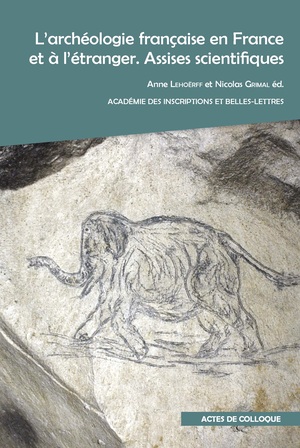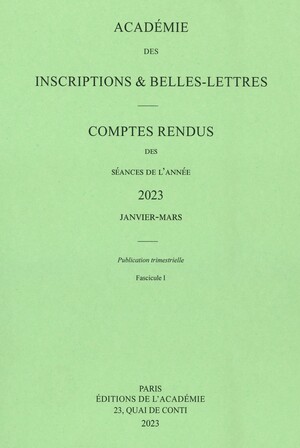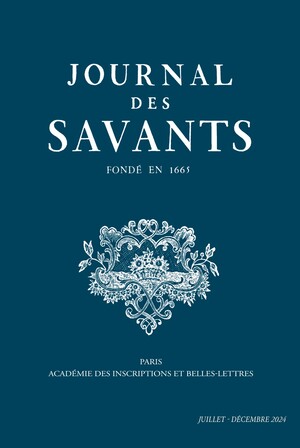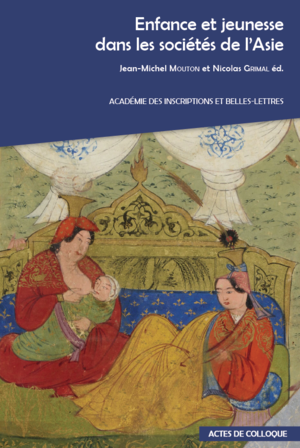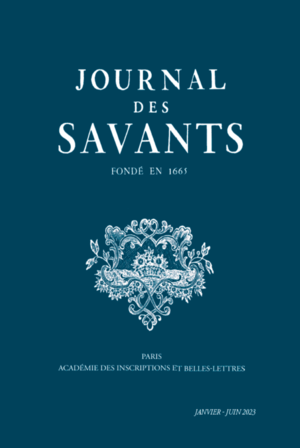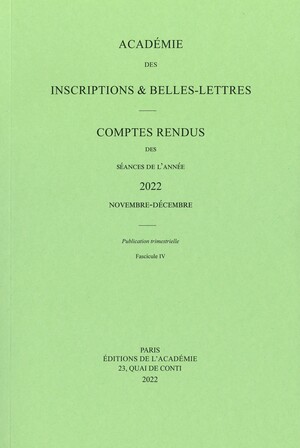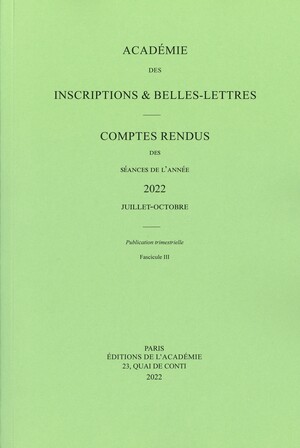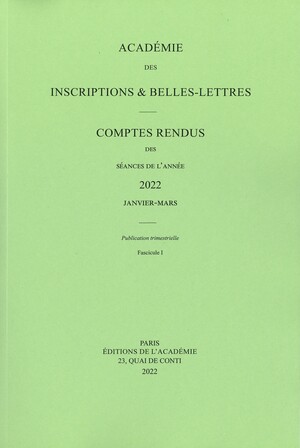Publications Archivum Latinitatis Medii Aevi 77, 2019
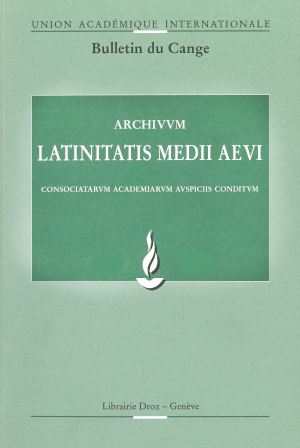
Archivum Latinitatis Medii Aevi, n° 77
Date : 2019
410 pages.
Pour se procurer ces périodiques :
Librairie Droz, 11 rue Massot Case Postale 389
1211 Genève 12 – Suisse
Tél : +41 22 346 66 66 ; Fax : +41 22 347 23 91
Site : www.droz.org
Courriel : droz@droz.org
Présentation
I. ARTICLES ET NOTES
BANNIARD M., Cum tamen aduersos cogor habere deos (Rome, -50)… Manducando filius meus panem ego morieba de famen (Burgos, + 950) : le latin et ses métamorphoses en diachronie longue, des fluctuations du latin classique aux nouvelles régulations du protoroman, p. 27-71
RÉSUME . – Cet article a pour but de présenter une synthèse à propos des découvertes et progrès récents dans le domaine de l’évolution langagière du latin classique au protoroman, après un demi-siècle de recherche innovante due au concept neuf de sociolinguistique diachronique mis en œuvre dans une convergence commune par un nombre significatif de chercheurs travaillant aussi bien en histoire de l’antiquité tardive et du haut moyen age qu’en philologie latine et romane, et qu’en linguistique. En premier lieu, il définit une nouvelle zone chronologique s’étendant du troisième au septième siècle et un nouvel objet spécifique, la dite « latinophonie tardive », tous deux définis comme un terme intermédiaire spécifique, du point de vue tant chronologique que typologique, entre la latinophonie classique et la romanophonie archaïque. En second lieu, il réfute l’explication de ce profond changement langagier par le recours démodé à une décomposition générale du latin en tant que conséquence mortelle d’une civilisation « décadente », et il insiste à rebours sur le rôle éminent des facteurs internes positifs à l’œuvre dans cette métamorphose. En troisième lieu, il cite une série de documents pragmatiques dont la langue écrite doit être caractérisée non plus comme du « vieux » latin, mais comme du latin « nouveau », autrement dit du roman archaïque, fréquemment caché (dans le passé) et se dissimulant (dans le présent) sous une graphie latiniforme, régulière ou erratique, comme les propres acteurs de ces siècles comblaient adroitement le fossé invoqué entre la langue parlée et la langue écrite : l’histoire documentée par écrit des langues romanes doit ainsi commencer dès le VIIIe siècle.
ABSTRACT. – This paper aims at building a synthesis about the last discoveries and improvements in the field of linguistic evolution from classical Latin to early Romance, after half a century of innovative research due to the new concept of diachronic sociolinguistics operated in a common convergence by a noteworthy number of resarchers working as well in late antique and high medieval history as in Latin or Romance philology or in linguistics. First, it delineates a new chronological zone, extending from the third to the seventh century, and a new specific object, the so called ‘late Latinophonia’, both of them outlined as a specific, chronologically and typologically, mediate term between classical Latinophonia and archaïc Romanophonia. Second, it rebukes the inappropriate explanation of this deep linguistic change by the old fashioned account of a general decaying of Latin as a deadly consequence of an alleged « decadent » civilisation, and reversely insists upon the preeminent role of internal positive factors performing the metamorphosis. Third, it quotes many pragmatic documents whose written langage must be no longer typified as « old » Latin but as « new » Latin, that is to say archaïc Romance, in very highly frequent instances hidden (in the past) and hiding (in modern times) under a regular or an irregular Latin-like way of writing, the very actors of these centuries filling skillfully the alleged gap between spoken and written language : the written story of the romance languages has to start as soon as the eighth century.
COMPENDIUM . – Opusculum illud conatur paucis exponere uerbis, quibus nouis inuentis documentis atque qua meliore ratione interpretandi instituta, nunc tandem clarius securiusque de lingua latina mutata e romana antiqua norma in nouum rusticum medii aeui usum, rationem liceat reddere. Quod factum est expletis per quasi saeculum medium inuestigationibus noui modi, quae quidem noua elicitae sunt ex cogitatione, quae scientia de coniunctione inter linguas ac mores in societate hominum hodie nuncupatur. Qua scientia uti soliti sunt hoc tempore haud pauci docti, quippe qui itinere communi tam de ultimi imperii romani ac de prioris medii aeui actis, quam de latina siue romana philologia, quamque de grammatica arte inquirerent. Primo, nouum temporis spatium ab tertio usque ad septimum saeculum extensum, atque nouam rem propriam, quae « latinophonia ultima » dicitur, definit, utrumque sic quidem ut uerbum proprii generis tam e temporum ordine quam e partium genere constitutum, ideoque inter latinophoniam ueterem et romanophoniam priorem illatum. Iterum, sententiam communem explodit qua, cur lingua latina ad pessimum mutata fuerit, ab obsoleta causa pendit latinae linguae toto orbe tabescentis perituraeque decadente immo potius pereunte studio litteralium artium. Rursus autem rationes erigit intimas ac uiuaces, quaequidem motus magni momenti impulserunt e quibus mutatio orsa sit alta. Tertio, documenta ad res gerendas scripta profert nonnulla, quorum litterata lingua non « ueteris » sed « noui » latini specie excussa esse uidetur, id est romanae rusticae linguae, quae persaepe olim celata, nunc se ipsa celat sub simulante latinam litteram tegumento, seu ordinato seu errante, cum illa aetate rerum agentes ciues humanarum curarent ipsi ut inter uerba et scripta extensam scilicet intermissionem callide cohibuisse uiderentur. Quam ob rem historia romanarum linguarum rusticarum ab scriptis monumentis elaborata ab ipso octauo saeculo incipi decet.
FERRI R., ZAGO A., Isidoro e i vocabolari antichi dell’uso, p. 73-95
RIASSUNTO . – Il contributo discute alcuni lemmi greco-latini contenuti negli Hermeneumata Celtis, vasto glossario bilingue organizzato per capitoli tematici : le forme latine dei lemmi, tutte di difficile interpretazione, possono essere meglio comprese alla luce di alcuni passi isidoriani delle Differentiae e delle Etymologiae. Il rapporto così istituito fra gli Hermeneumata Celtis e Isidoro si presta a interpretazioni differenti in termini di reciproca dipendenza, che vengono indagate nella seconda parte del lavoro. La conclusione cui si giunge è che Isidoro utilizzava glossari bilingui greco-latini simili agli Hermeneumata Celtis.
ABSTRACT. – The article examines some Greek-Latin lemmata included in the so-called Hermeneumata Celtis, a large bilingual thematic glossary. The Latin lemmata, all of complex interpretation, are best understood in the light of some passages from Isidore’s Differentiae and Etymologiae. The relationship thus established between Hermeneumata Celtis and Isidore can yield different interpretations in terms of mutual dependence, which are discussed in the second half of the paper. The conclusion we reach is that Isidore drew from bilingual Greek-Latin glossaries resembling Hermeneumata Celtis.
AGUILAR MIQUEL J., Le manuscrit Paris, BnF, lat. 2306 des Sententiae de Taion de Saragosse : étude d’un exemplaire de la bibliothèque de Jacques-Auguste de Thou, p. 97-111
RÉSUME . — Le manuscrit Paris, BnF, lat. 12265 des Sententiae de Taion de Saragosse (VIIe s.) a été copié dans le scriptorium de Saint-Germain-des-Prés dans la seconde moitié du XVIIe siècle ; l’editio princeps de l’Epistula ad Quiricum Barcinonensem antistitem (prologue des Sententiae), de son côté, a été préparé par Luc d’Achery et Jean Mabillon dans la même institution en 1669. Ces deux témoins semblent avoir utilisé comme modèle le même exemplaire : un manuscrit carolingien appartenant à la célèbre bibliothèque de Jacques-Auguste de Thou (1553-1617), qui n’était pas identifié jusqu’à présent. L’étude du texte permet d’affirmer que ce manuscrit est en fait le manuscrit Paris, BnF, lat. 2306. Ce travail fournit des preuves textuelles, codicologiques et historiques permettant de démontrer cette hypothèse et de déterminer quelles sont les relations exactes de ces deux manuscrits (lat. 2306 et lat. 12265) et l’édition de Mabillon.
ABSTRACT. – The manuscript Paris, BnF, lat. 12265 of Taio Caesaraugustanus’s Sententiae (VIIth century) was copied in the scriptorium of Saint-Germain-des-Prés in the second half of XVIIth century ; the editio princeps of the Epistula ad Quiricum Barcinonensem antistitem (Sententiae’s prologue) was prepared by Luc d’Achery and Jean Mabillon himself at the same institution in 1669. Both witnesses seem to have use the same specimen as a model : a Carolingian manuscript coming from the famous library of Jacques-Auguste de Thou (1553-1617). The study of the text allows me to affirm that this manuscript is actually the Paris, BnF, lat. 2306. This paper provides textual, codicological and historical evidence in order to prove this hypothesis and unravel the exact relationships between both manuscripts (lat. 2306 and lat. 12265) and Mabillon’s edition.
SPANGENBERG YANES E., Una nuova ipotesi su bannita (sillaba) nel latino medievale, p. 113-123
RIASSUNTO . — La prima parte dell’articolo riguarda il termine bannita, che occorre in alcuni testi grammaticali altomedievali con il significato di ‘sillaba’. Nel 1976 Bernhard Bischoff spiegò l’oscura origine di questo vocabolo con l’ipotesi che esso risultasse da un errore di separazione delle parole in una frase in greco nel libro I delle Etymologiae di Isidoro, traslitterata in latino nei manoscritti. Questa spiegazione è stata accolta negli studi successivi ; la prima completa collazione dei codici medievali del Commentarium de litteris di ‘Sergio’ rivela ora però che bannita occorre come parola a sé stante già nella maggior parte dei testimoni altomedievali di ‘Sergio’. Si può pertanto individuare nella tradizione manoscritta di ‘Sergio’ piuttosto che in quella di Isidoro la fonte del neologismo medievale bannita. La seconda parte del contributo indaga l’uso peculiare di bannita con il valore di “lettera” nel Tractatus super Donatum di Ercanberto di Freising, che deve essere iscritto nel contesto degli scriptoria e circoli eruditi irlandesi sul continente in epoca carolingia.
ABSTRACT. —The first part of the paper focuses on the word bannita, which occurs in some early medieval Latin grammatical works with the meaning of ‘syllable’. In 1976 Bernhard Bischoff explained the uncertain origin of this term conjecturing that it resulted from the wrong separation of the words in a transliterated into Latin and corrupt Greek phrase in book 1 of Isidorus’ Etymologiae. This explanation has been accepted for a long time, but now the first complete collation of the medieval manuscripts of Sergius’ Commentarium de litteris reveals that bannita occurs as a self-standing word already in the majority of Sergius’ early medieval witnesses. It is therefore possible to identify in Sergius’ manuscript tradition rather than in that of Isidorus the source for such medieval neologism. The second part of the paper investigates the peculiar use of bannita as “letter” in the Tractatus super Donatum by Erchanbert of Freising, placing it in the context of the Irish scholarly circles and scriptoria in Carolingian Europe.
RUSSO A., Uno zibaldone « artificiale » di Paolo Diacono : Paris, BnF, Lat. 528, fol. 121-139, p. 125-158
RIASSUNTO. — Il codice Paris, BnF, Lat. 528 è una miscellanea scolastica assemblata nel monastero di Saint-Denis tra la fine dell’VIII e l’inizio del IX sec. Al suo interno è possibile isolare i fol. 121-139 (= P), in quanto unità autonoma dal punto di vista codicologico e contenutistico. Essi trasmettono una silloge di carmi dell’entourage carolingio risalenti agli anni ’70 e ’80 dell’VIII sec., e alcuni materiali didattici. Il compilatore mostra interessi in linea con la riforma scolastica voluta da Carlo Magno, e un evidente orientamento alla didattica. Alcune caratteristiche della collezione poetica di P inducono ad ipotizzare che il codice sia una sorta di zibaldone di Paolo Diacono, nato copiando in un unico manoscritto testi raccolti da Paolo negli anni del soggiorno francese (782-785) e conservati su schede o fogli sciolti in un suo ipotetico archivio personale. Questa ipotesi è confermata dall’esame dei materiali non poetici di P. Il codice non è né autografo di Paolo né idiografo, ma costituisce un prezioso specchio della sua attività intellettuale e didattica in Francia negli anni ’80 dell’VIII sec.
RÉSUME . — Le manuscrit Paris, BnF, Lat. 528 est un livre scolaire assemblé à l’abbaye de Saint-Denis entre la fin du VIIIe et le début du IXe siècle. Les fol. 121-139 (= P) peuvent être isolés et considérés comme une unité codicologique autonome. Ils sont indépendants aussi quant à leur contenu. Ils transmettent un recueil de poèmes provenant de l’entourage carolingien (des années 70 et 80 du VIIIe s.) et des textes didactiques. Le compilateur de ce corpus montre des intérêts conformes à ceux des intellectuels qui participaient aux réformes scolaires voulues par Charlemagne au début de son règne. Certains aspects du corpus poétique de P permettent t’envisager l’hypothèse que ce manuscrit soit une sorte de recueil personnel de Paul Diacre, formé par l’assemblage de textes qu’il avait recueillis pendant son séjour en France (782-785), et qui circulaient sur des papiers ou des fiches personnels. L’étude des matériaux non-poétiques de P confirme cette hypothèse. On peut exclure que P soit un autographe ou idiographe de Paul, mais il est un précieux document de son activité intellectuelle et didactique dans les années 80 du VIIIe siècle.
ABSTRACT. – The manuscript Paris, BnF, Lat. 528 is a school miscellany produced in the abbey of Saint-Denis in the late VIIIth or early IXth century. The fol. 121-139 (= P) make an independent section, both for their codicological features and their content. They preserve a collection of poetry from the Carolingian circle dating from the decades 770 and 780, and some school materials. The compiler of this collection shows interests that perfectly fit those of a learned man of the first Carolingian renaissance. Some peculiar aspects of the poetry collection in P support the hypothesis that this manuscript was realized by copying texts that Paul the Deacon had collected during his years in France (782-785) and that were preserved in a personal archive on unbound leaves. The study of the non-poetical texts in P supports this view. It is clear that P is not an autograph or an idiograph manuscript of Paul, but it is a precious document of his intellectual and didactic activity in France during the 780s.
BOURGAIN P., Rapports de la ponctuation avec la construction grammaticale, p. 159-19
RÉSUME . — La ponctuation a toujours fait en principe partie de la grammaire, mais dans l’Antiquité elle a été traitée tantôt en termes génériques (la distinctio étant une opération grammaticale), tantôt et plus souvent dans un contexte rhétorique. Au cours du Moyen Âge, de plus en plus de théoriciens font appel à la grammaire et s’expriment en termes de syntaxe pour exposer leur conception de la ponctuation. Les difficultés éprouvées à combiner l’aspect stylistique et une analyse grammaticale ont amené ces théoriciens, notamment à partir du XIIe siècle, à s’appuyer davantage sur la syntaxe pour comprendre les termes de ponctuation et structurer les textes. Inversement, en stylistique, définir les pauses de ponctuation comme marquant le dépendant, le suffisant et l’accompli aboutit à codifier les règles du dictamen selon des principes presque autant grammaticaux que stylistiques, sur un rythme dominant à trois temps qui s’accommode bien des triades de la ponctuation.
ABSTRACT. – Punctuation has always been in principle a part of grammar, but during Antiquity it was treated sometimes in generic terms (for distinctio is a grammatical operation), sometimes and more often in a rhetorical context. During the Middle Ages, more and more theorists appeal to grammar and use syntactic terminology to explain their own conception of punctuation. From the xiith century onwards, difficulties in combining stylistics with grammatical analysis led these theorists to rely more on syntax to understand punctuation terms and to structure the texts. Conversely, in stylistics, defining punctuation pauses as marks of dependance, sufficiency and finitude leads to codify the rules of dictamen according to principles that are almost as grammatical as they are stylistic, with a dominant threefold rhythm in agreement with the triads of punctuation.
D’ARGENIO E., Novità lessicali nel Codice Diplomatico Barese : le Pergamene di S. Nicola di Bari (939-1266), p. 193-205
RIASSUNTO . — Il contributo presenta i risultati di un’indagine lessicografica volta all’individuazione e all’esame delle novità lessicali che si trovano nei documenti editi nei volumi quarto, quinto e sesto del Codice Diplomatico Barese. Questa raccolta documentaria, come si sa, riveste particolare importanza per il progresso della lessicografia mediolatina, in quanto documenta numerosi vocaboli che non sono ancora registrati nei dizionari di latino medievale. Sono in questa sede analizzati alcuni significativi neologismi semasiologici (altare, calaprix, capitellum, castrum, cervical, costalis, dalfinus, manganellum, pasola, nauclerius) e semantici (abstractor, adpignerare, appignatio, bardarius, camminatella, celame, corbarius, confectarius, milella, pisarola, serrone, serrosus, suppinnum, suppinnulum, suppinnatus, specclulina, tectumen, triscile).
ABSTRACT. –This paper discusses results of a lexicographic investigation aimed at analysing the lexical innovations contained in the documents published in the fourth, fifth and sixth volumes of the Codice Diplomatico Barese. As is well known, this documentary collection is of particular importance in the development and progress of medieval Latin lexicography, as it attested a considerable number of words which are not included in the medieval Latin dictionaries. The paper focuses on relevant semasiological neologisms (altare, calaprix, capitellum, castrum, cervical, costalis, dalfinus, manganellum, pasola, nauclerius) and semantic neologisms (abstractor, adpignerare, appignatio, bardarius, camminatella, celame, corbarius, confectarius, milella, pisarola, serrone, serrosus, suppinnum, suppinnulum, suppinnatus, specclulina, tectumen, triscile).
ŠEDINOVÁ H., Non vivens nisi per unum diem. A Winged Aquatic Animal on Its Way from Aristotle to Thomas of Cantimpré, p. 207-234
ABSTRACT . — Apart from more or less well-known names of animals which are attested already in the Classical Latin and whose origins and meanings have been studied and traced by modern scholars, it is possible to find in medieval encyclopaedias other expressions that still lack a proper explanation of their etymology and meaning. Many unusual terms can be found in the encyclopaedia Liber de natura rerum written by Thomas of Cantimpré (13th century). Although modern researchers have gradually discovered that the curious animals were originally the species described by ancient natural scientists, medieval encyclopaedists could not decipher the unfamiliar names. One of these new terms is the name dies which denotes an unknown winged fish in medieval Latin encyclopaedias and glossaries. Thomas of Cantimpré invoked Aristotle to validate the information about the creature and modern researches have assumed that Thomas’ source was a passage concerning mayfly in the fifth book of Aristotle’s Historia animalium and that the word dies is a direct equivalent of the Greek ἐφήμερον, « mayfly ». In fact, Thomas found this term and the description of the animal in the Book I of Latin version of Aristotle’s Historia animalium, translated by Michael Scotus around 1220 from Arabic. Aristotle’s description of a bloodless animal endowed with four legs and four wings, which only lives one day after it reaches maturity, kept its original sense in the Arabic version of his treatise, in which the Greek adjective ἐφήμερον, « one-day », was replaced with the Arabic equivalent yaumī of the same meaning. Michael Scotus also translated the name, replacing the adjective with the noun dies, « day ». Thomas of Cantimpré, consequently, accepted Michael’s description, but asserted that dies is a bloodless marine fish which only lives one day and has two wings and two legs. His description of a « new » creature fascinated both the authors of encyclopaedic works (Albert the Great, Vincent of Beauvais, Jacob van Maerlant) and the medieval illustrators who depicted the dies as a hybrid with a fish head, tail and scales, with strong legs resembling lion’s paws, and with two massive feathered wings which allow it to fly over expanses of water.
Keywords : Thomas of Cantimpré ; see monsters ; fishes, Medieval encyclopaedias, mayfly ; dies ; ephemeron ; Aristotle ; Michael Scotus
RÉSUME . — Outre les noms d’animaux plus ou moins connus qui sont déjà attestés dans le latin classique et dont les origines et les significations ont été étudiées et retracées par les savants modernes, il est possible de trouver dans les encyclopédies médiévales d’autres expressions, dont l’étymologie et la signification ne sont pas encore bien expliquées. On trouve de nombreux termes inhabituels dans le Liber de natura rerum de Thomas de Cantimpré (XIIIe s.). Même si les chercheurs modernes ont progressivement découvert que les animaux curieux étaient, à l’origine, les espèces décrites par les anciens spécialistes des sciences naturelles, les encyclopédistes médiévaux n’ont pas pu décrypter les noms qui ne leur étaient pas familiers. L’un de ces nouveaux termes est le nom dies, qui désigne un poisson ailé inconnu dans les encyclopédies et glossaires latins médiévaux. Thomas de Cantimpré a invoqué Aristote pour valider les informations sur cette créature et les recherches modernes ont supposé que la source de Thomas était un passage concernant l’éphémère dans le cinquième livre de l’Historia animalium d’Aristote, et que le mot dies était un équivalent direct du grec ἐφήμερον, ‘éphémère’. En fait, Thomas a trouvé ce terme et la description de l’animal dans le livre I de la version latine de l’Historia animalium d’Aristote, traduit de l’arabe par Michel Scot vers 1220. La description d’Aristote d’un animal dépourvu de sang, doté de quatre pattes et de quatre ailes, qui ne vit qu’un jour après sa maturité, a gardé son sens original dans la version arabe de son traité, dans lequel l’adjectif grec ἐφήμερον, ‘qui ne vit qu’un jour’, a été remplacé par l’équivalent arabe yaumī de même sens. Michel Scot a également traduit le nom en remplaçant l’adjectif par le substantif dies, ‘jour’. Thomas de Cantimpré a donc accepté la description de Michel, mais a affirmé que dies est un poisson marin sans sang qui ne vit qu’un jour et qui a deux ailes et deux pattes. Sa description d’une « nouvelle » créature fascine à la fois les auteurs d’ouvrages encyclopédiques (Albert le Grand, Vincent de Beauvais, Jacob van Maerlant) et les illustrateurs médiévaux, qui dépeignent le dies comme un hybride avec une tête, une queue et des écailles de poisson, avec de fortes pattes ressemblant à des pattes de lion, et avec deux ailes massives à plumes qui lui permettent de voler au-dessus des étendues d’eau.
Mots clés : Thomas de Cantimpré ; monstres marins ; poissons, encyclopédies médiévales, éphémère ; dies ; ephemeron ; Aristote ; Michel Scot
HAYE Th., Gnade für Lüttich ! Ein Gedicht über die Schlacht von Othée (1408) und deren Folgen, p. 235-274
ZUSAMMENFASSUNG . — Im Jahre 1406 verjagt die Lütticher Bürgerschaft ihren Stadtherrn, den bischöflichen Elekten Johann VI. von Bayern. Doch seine zu Hilfe gerufenen Verwandten, der holländische Graf Wilhelm IV. und der burgundische Herzog Johann Ohnefurcht, vernichten am 23. September 1408 in der Schlacht von Othée die Miliz der Aufständischen. In der Folge verliert die Stadt ihre kommunalen Freiheiten und wird brutal unterdrückt. Ein bislang unbekanntes lateinisches Gedicht, das wohl 1415 von einem Lütticher Anonymus verfasst worden ist, behandelt das Thema sowohl aus der Sicht der Sieger als auch der Besiegten. Es reflektiert die politische Zerrissenheit des lokalen Klerus und appelliert an die Gnade des bischöflichen Elekten. Der Aufsatz bietet eine kritische Edition des Textes (auf der Basis der Handschrift Basel, UB, F.V.6), einen Kommentar sowie eine historisch-philologische Einordnung.
ABSTRACT. – In 1406 the citizens of Liège chased away their lord, the bishop-elect John VI of Bavaria. But his relatives, the Dutch Count William IV and the Burgundian Duke John the Fearless, who were called to help, destroyed the militia of the rebels in the battle of Othée (23 September 1408). As a result, the city lost its communal liberties and was brutally oppressed. A hitherto unknown Latin poem, probably written in 1415 by an anonymus author from Liège, deals with the subject from the point of view of both the victors and the defeated. It reflects the political disunity of the local clergy and appeals to the grace of the bishop-elect. The essay offers a critical edition of the text (based on the manuscript Basel, UB, F.V.6), a commentary, and a historical-philological interpretation.
II. Actes du XXIIe congrès annuel de la Società Internazionale per lo Studio del Medioevo Latino (SISMEL), Florence, 12 avril 2019 : Il racconto delle parole. La lessicografia latina nel Medioevo : lingua, letteratura e cultura.
GATTI P., Glossari e altre raccolte, p. 277-290
RIASSUNTO. – Panoramica sui principali tipi di raccolte lessicografiche latine (Festo, Nonio, Fulgenzio e Synonyma Ciceronis, Differentiae verborum, glossari). Si suggerisce anche di attualizzare il Thesaurus glossarum emendatarum di Georg Goetz.
ABSTRACT. — The aim of this contribution is to outline the most important kinds of the lexicographical collections (Festus, Nonius, Fulgentius and Synonyma Ciceronis, Differentiae verborum, glossaries). It also recommends to update the Thesaurus glossarum emendatarum of Georg Goetz.
ALBERTO P. F., L’Epistula sancti Hieronymi de nominibus pedum e Isidoro di Siviglia, p. 291-333
RIASSUNTO . — Studio ed edizione di tre testi sui nomi dei piedi grammaticali, desunti da un estratto del libro III dell’Ars grammatica di Plozio Sacerdote, composto forse nella tarda antichità. Il primo, attribuito dalla tradizione a Girolamo e a Isidoro, si trova in Paris, BnF, lat. 7520, e in Città del Vaticano, BAV, Reg. lat. 1586, ambedue della metà del IX secolo, e in codici più tardi delle Etimologie. La seconda versione è stata incorporata in un De pedibus copiato in München, BSB, Clm 6411, del IX secolo, una redazione particolare del capitolo 17 del libro I delle Etimologie, arricchita con estratti da Mallio Teodoro e Servio Onorato. Il terzo, attribuito a Girolamo e copiato in Paris, BnF, lat. 7491, del IX secolo, e in Oxford, Bodleian Library, Auct. T.2.18, della fine del IX o dell’inizio del X secolo, si caratterizza per la presenza di elementi rintracciabili, in molti casi, nella tradizione grammaticale dei secoli VIII e IX. Essi illustrano una categoria di strumenti semplici del sapere grammaticale, in uso nella seconda metà dell’VIII e nella prima metà del IX secolo e, soprattutto, apportano dati nuovi e spiegazioni per la dottrina altomedievale dei nomi dei piedi metrici.
ABSTRACT. – This article explores three grammatical texts on the names of the metrical feet. They derive from a model mainly composed of excerpts from Plozio Sacerdos’ Ars grammatica, Book III. One of them was transmitted under the authorship both of Jerome and Isidore of Seville. It is found in Paris, BnF, lat. 7520 and Città del Vaticano, BAV, Reg. lat. 1586, of the ninth century, and in later exemplars of the Etymologies. Another version, enhanced with Isidore’s definitions, was incorporated in a particular redaction of chapter 17 of the Etymologies, book 1, copied in München, BSB, Clm 6411, of the ninth century. The last piece, also attributed to Jerome in the manuscript tradition, incorporates contemporary grammatical theory, and is found in the ninth-century Paris, BnF, lat. 7491, and in Oxford, Bodleian Library, Auct. T.2.18, of the late-ninth or the early-tenth century. These pieces exemplify a class of elementary grammatical tools in use in the second part of the eighth and the first part of the ninth century. Occasionally, they provide new explanations for the names of the feet. An edition of the three texts is given in an Appendix.
ARTEMISIO F., Syrma id est longaria : analisi e fortuna di una glossa controversa, p. 335-347
RIASSUNTO. – Il contributo ricostruisce l’origine e la fortuna di una particolare definizione della voce greca syrma (longaria o longae manus scriptura) in epoca medievale. Nella sua accezione primigenia di « veste tragica », il termine presenta nel latino d’epoca classica esigue attestazioni, e ancor minori sono i casi in cui esso assume il valore metonimico di « tragedia » ; non sarà dunque un caso che il grecismo, per la sua rarità, abbia attirato l’attenzione degli esegeti carolingi, ai quali si deve, probabilmente per sovrapposizione di informazioni, la nascita di un tecnicismo grafico.
ABSTRACT. – The paper aims to reconstruct the origin and transmission of an unusual definition of the Greek word syrma (longaria or longae manus scriptura) during the Middle Ages. Regarding its primordial meaning of « tragic guise », the term has little evidence in the Classical Latin period, and even fewer cases in which it acquires the metonymic value of « tragedy ». Because of its rarity, it is no coincidence that the Grecism has attracted the attention of Carolingian exegetes. Due to their elaboration of overlapping notions, the lemma syrma became a technical term.
DUPLESSIS F., « Min non, erua mortalis » : apparition et diffusion de l’étymologie carolingienne de Minerve, p. 349-373
RÉSUMÉ . — Pour expliquer l’origine du nom Minerua, associé depuis l’Antiquité à l’adjectif immortalis, une étymologie surprenante a vu le jour au cours du IXe siècle : « Min non, erua mortalis ». La première partie de cette étude analyse les passages des commentaires de Jean Scot et Remi d’Auxerre sur Martianus Capella où l’on rencontre les plus anciennes occurrences de cette étymologie. La confrontation des méthodes de travail de ces deux savants invite à considérer que cette étymologie a probablement été inventée par Jean Scot. La seconde partie de cet article est consacrée à la fortune de cette étymologie carolingienne durant le Moyen Âge. Grâce au succès du commentaire de Remi sur le De Nuptiis, on la retrouve dans plusieurs lexiques et traités mythographiques ainsi que dans de nombreux commentaires.
ABSTRACT. – To explain the origin of the noun Minerua, associated since antiquity with the adjective immortalis, a surprising etymology emerged during the ninth century : « Min non, erua mortalis ». The first part of this article analyses the passages in the commentaries of John Scotus and Remigius of Auxerre on Martianus Capella where the oldest occurrences of this etymology are found. A comparison of the working methods of these two scholars invites us to consider that this etymology was probably invented by John Scotus. The second part of this article deals with the fortune of this Carolingian etymology during the Middle Ages. Thanks to the success of Remigius’ commentary on De Nuptiis, this etymology can be found in several lexicographical works and mythographic treatises as well as in numerous commentaries.
FÜHRER D., Synonymes, définitions, explications : aspects lexicographiques dans les commentaires de l’Alexandréide, p. 375-385
RÉSUMÉ . — Dans le passé, les gloses lexicales ont été considérées principalement comme un outil devant fournir des explications de mots difficiles ou obscurs à l’attention d’étudiants au vocabulaire limité. Cet article présente différentes fonctions de ce type de gloses et démontre leur lien avec les explications lexicographiques et encyclopédiques en marge du texte en prenant comme exemple le commentaire de l’Alexandréide de Gautier de Châtillon. En effet, les explications ne servent pas seulement à faciliter la compréhension de certains mots, mais aussi à orienter l’interprétation du passage en question. Ceci semble même être leur objectif principal. Elles contribuent également à enrichir le vocabulaire de leurs lecteurs, leur fournissant des synonymes à prosodie variable et établissant de véritables champs lexicaux ; enfin, elles familiarisent les étudiants avec la méthode étymologique, spécialement à la dérivation comme outil servant à la déduction et à la mémorisation de termes connectés. L’approche méthodologique et la connaissance de textes littéraires apparaissant à travers le commentaire témoigne de la culture du commentateur.
ABSTRACT. – In the past, lexical glosses have mostly been conceived as a tool for teaching the meaning of obscure words to students with a limited vocabulary. The following paper aims to point out different functions of this type of glosses and to trace their connections to lexicographic and encyclopaedic scholia by the example of the commentary on Walter of Châtillon’s Alexandreis. The explanations turn out not only to help understand the meaning of certain words, but also to influence the interpretation of the passage concerned. In fact, the latter often seems to be their main objective. In addition, they serve to broaden the vocabulary of their readers, providing them with metrically varied synonyms and establishing different lexical fields ; and they introduce the students to the etymological method, especially to derivations as an aid to deduce and memorise the meaning of (alleged) compounds. The methodological approach and the knowledge of literature manifested in the commentary, bear witness to the commentator’s philological expertise.
CREMASCOLI G., Sul lessico teologico nel Catholicon di Giovanni Balbi, p. 387-400
RIASSUNTO . — Da varie ricerche, condotte negli ultimi anni, risulta che i più noti lessicografi mediolatini – cioè Papias, Osberno, Uguccione da Pisa – intesero il loro compito come di natura soprattutto grammaticale e di derivatio nominis, quasi trascurando l’approfondimento delle novità semantiche introdotte dalla teologia e dalla prassi cristiana. Il sistema mutò radicalmente con Giovanni Balbi, teologo dell’Ordine dei Predicatori, autore del monumentale lessico intitolato Catholicon, attento alla derivatio nominis ma anche impegnato nell’affiancare, in alcuni casi, ampie trattazioni riguardanti la cogitatio fidei o gli apparati dell’istituzione cristiana. Il presente saggio prende in considerazione alcuni lemmi, ritenuti particolarmente significativi. Si tratta di tradux, eucaristia, missa, communio, Trinitas. Speciale attenzione hanno ricevuto, nel saggio, altri vocaboli molto in uso nei dibattiti trinitari e cristologici dei primi secoli cristiani. Traslitterati dal greco anche con difformità ed incertezze, subirono, nei lessici mediolatini compreso il Catholicon, disavventure non lievi, cruces per chi si impegnasse a fissarne criticamente le grafie e i significati. In altri casi si delineano situazioni tipiche dell’istituzione cristiana, come, ad esempio, con ordo e ove si evocano i vari gradi della gerarchia ecclesiastica.
ABSTRACT. – Recent research conducted on the most well-known Medieval Latin lexicographers – Papias, Osbernus, Hugutio Pisanus – has revealed that they understood their task to be of an essentially grammatical and derivatio nominis nature, almost overlooking detailed analysis of the semantic innovations introduced by theology and Christian practice. The system changed radically with Giovanni Balbi, theologian of the Ordo Praedicatorum, author of the monumental lexicon Catholicon, attentive to the derivatio nominis but also committed to supporting, in some cases, ample treatises bearing on cogitatio fidei or the apparatuses of Christian institutions. This essay addresses certain lemma considered to be particularly significant : tradux, eucaristia, missa, communio, Trinitas. Other words frequently in use in Trinitarian and Christological debates in early Christianity are given special attention in the essay. Transliterated from the Greek with corruptions and approximations, they experienced considerable misfortune in Medieval Latin lexicons, including the Catholicon, cruces for anyone intent on establishing critically proper spelling and meaning. In other cases, situations common to Christian institutions come to the fore, as for example with ordo, and where the various levels of ecclesiastical hierarchy are evoked.
LUNARDINI V., Lessici mediolatini on-line. L’esperienza di Mirabile, p. 401-410
RIASSUNTO . — Nel saggio è descritto il progetto LeMeL (Lessici Mediolatini) che, all’interno della Sezione Lessicografica della S.I.S.M.E.L., è strutturato in tre fasi : il reperimento di testi dispersi in varie biblioteche e presso case editrici non sempre accessibili ; la resa in formato elettronico dei testi. Ciò ha permesso la scansione di tutti i testi immessi in LeMeL ; la riduzione in pdf ricercabile di tutti questi testi per poter permettere la reperibilità dei vocaboli. Il materiale inserito in LeMeL comprende opere di grandezza variabile, fra le quali le raccolte edite nel Corpus Glossariorum Latinorum (7 volumi) e nei Glossaria Latina (5 volumi), l’Elementarium di Papias (incunabulo del 1496 ed edizione critica della lettera A, a cura di V. de Angelis), le Derivationes di Osberno, le lettere A-C delle Derivationes e l’Agiographia di Uguccione da Pisa, il Doctrinale di Alessandro de Villadei, il Graecismus di Eberardo di Béthune, la Summa Britonis sive Expositiones vocabulorum Biblie di Guglielmo Bretone, l’Expositio sermonum antiquorum di Fulgenzio, le Etymologiae di Isidoro di Siviglia e il De lingua latina di Varrone. Le proposte per il futuro prevedono più livelli. Innanzitutto creare collegamenti con indici lessicali già esistenti, come ad esempio l’indice lessicale di Medioevo Latino, nell’intento di giungere alla creazione di un thesaurus sempre più ricco dei lasciti lessicografici della latinità medievale.
ABSTRACT. – This essay lays out the LeMeL (Lessici Mediolatini – Medieval Latin Lexicons) project which, within the S.I.S.M.E.L. Sezione Lessicografica (Lexicography Section), is structured in the following phases : the location of texts dispersed in various libraries and not easily accessible publishing houses and their rendering in digital form. This has made possible the scansion of all texts inserted in LeMeL and their conversion into searchable pdfs in order to make vocabulary available. The material inserted in LeMeL comprises works of various lengths among which the edited collections in the Corpus Glossariorum Latinorum (7 volumes) and in the Glossaria Latina (5 volumes), the Elementarium by Papias (the 1496 incunabulum and the critical edition of the letter A, ed. V. de Angelis), the Derivationes by Osbernus, the letters A-C of the Derivationes and the Agiographia by Hugutio of Pisa, the Doctrinale by Alexandre de Villadieu, the Graecismus by Eberard de Béthune, the Summa Britonis sive Expositiones vocabulorum Biblie by Guillaume Le Breton, the Expositio sermonum antiquorum by Fulgentius, the Etymologiae by Isidore of Seville and the De lingua latina by Varro. Proposals for the future envision more levels : first of all, the creation of connections with already existing lexical indices as, for example, the Medioevo Latino lexical index, with the objective of arriving at the creation of an increasingly rich thesaurus of the lexigraphical legacy of the Latin Middle Ages.
- TILLIETTE J.-Y., In memoriam. Peter Stotz (1942-2020)
I. ARTICLES ET NOTES
- SMIRAGLIA P., POLARA I., DE PRISCO A., Latinitatis italicae medii aevi lexicon. Addenda -Series altera. Fasc. 17 : palpatus – patrocinium
- BANNIARD M., Cum tamen aduersos cogor habere deos (Rome, -50)… Manducando filius meus panem ego morieba de famen (Burgos, +950) : le latin et ses métamorphoses en diachronie longue, des fluctuations du latin classique aux nouvelles régulations du protoroman
- FERRI R., ZAGO A., Isodoro e i vocabolari antichi dell’uso
- AGUILAR MIQUEL J., Le manuscrit Paris, BnF, lat. 2306 des Sententiae de Taion de Saragosse : étude d’un exemplaire de la bibliothèque de Jacques-Auguste de Thou
- SPANGENBERG YANESs E., Una nuova ipotesi su bannita (sillaba) nel latino medievale
- RUSSO A., Uno zibaldone ‘‘artificiale’’ di Paolo Diacono : Paris, BnF, Lat. 528, fol. 121-139
- BOURGAIN P., Rapports de la ponctuation avec la construction grammaticale
- D’ARGENIO E., Novità lessicali nel Codice Diplomatico Barese : le Pergamene di S. Nicola di Bari (939-1266)
- ŠEDONIVA H., Non vivens nisi per unum diem. A Winged Aquatic Animal on Its Way from Aristotle to Thomas of Cantimpré
- HAYE Th., Gnade für Lüttich ! Ein Gedicht über die Schlacht von Othée (1408) und deren Flogen
II. Actes du XXIIe congrès annuel de la Società Internazionale per lo Studio del Medioevo Latino (SISMEL)
- GATTI, P., Gloassari e altre raccolte
- ALBERTO P. F., L’Epistula sancti Hieronymi de nominibus pedum e Isidoro di Siviglia
- ARTEMISIO, F., Syrma id est longaria : analisi e fortuna di una glossa controversa
- DUPLESSIS, F., ‘‘Min non, erua mortalis’’ : apparition et diffusion de l’étymologie carolingienne de Minerve
- FÜHRER, D., Synonymes, définitions, explications : aspects lexicographiques dans les commentaires de l’Alexandréïde
- CREMASCOLI, G., Sul lessico teologico nel Catholicon di Giovanni Balbi
- LUNARDINI V., Lessici mediolatini on-line. L’esperienza di Mirabile

